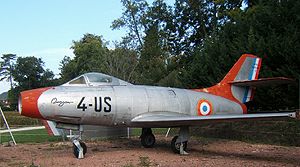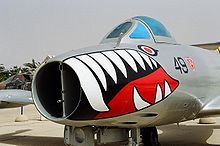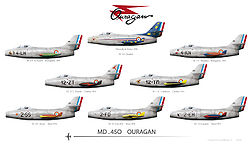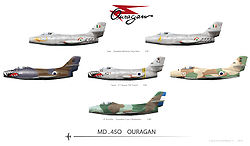Dassault Ouragan Video - Historical video
|
|
Dassault Ouragan
Ouragan

Picture - A Dassault Ouragan with French Air Force markings
Role: Fighter-bomber
Manufacturer: Dassault Aviation
Designed by: Marcel Dassault
First flight: 28 February 1949
Introduced: 1952
Retired: 1980s
Primary users: French Air Force
El Salvador Air Force
Indian Air Force
Israeli Air Force
The Dassault M.D.450 Ouragan (French: Hurricane) was the first French-designed jet fighter-bomber to enter production, playing a key role in resurgence of the French aviation industry after World War II. The Ouragan was operated by France, Israel, India and El Salvador. While in Israeli service it participated in both the Suez Crisis and Six-Day War.
Design and development
As citizens of an occupied country, the French were not able to contribute significantly to the great strides made in aircraft design made during World War II. After the war, aviation designer Marcel Dassault was eager to re-establish the aviation industry with an all-French jet fighter, which was outlined in 1947. The government response to the proposal was positive and prototype construction began soon after the design was finalized.
Detailed design work on the new aircraft, which was given the designation M.D. (Marcel Dassault) 450, began in October 1947, with construction beginning on 7 April 1948 at Dassault's factory in Saint-Cloud. A French government contract for three prototypes followed on 7 December 1947. The first Ouragan fighter flew on 28 February 1949 with Kostia Rozanoff at the controls. The M.D.450-01 prototype lacked pressurization, armament, and the distinctive wingtip fuel tanks. Powered by a Rolls-Royce Nene 102 centrifugal-flow jet engine generating 22.27 kN (2,270 kp/5,000 lbf) of thrust, the aircraft reached a top speed of 980 km/h (529 knots, 609 mph) and initial climb rate of 43 m/s (8,465 ft/min) in service trials in 1949. The 450 liter (118.9 US gal) wingtip tanks that would become the indelible feature of all Ouragans first appeared in December 1949. The pressurized second prototype, M.D.450-02, climbed to 15,000 m (49,213 ft), while the third prototype, M.D.450-03, was powered by a Hispano-Suiza-licensed Nene 104 was used in weapons trials with 15 mm and later 20 mm cannon.
In 31 August 1949, French Air Force ordered 15 pre-production aircraft (later reduced to 12), which were eventually used for evaluation of various engines (including SNECMA Atar), armament schemes, and payloads. The contract was signed on 15 December 1949. These aircraft were to be produced at Dassault's plants outside Paris. On 31 August 1950, Dassault received an order for 150 production Ouragans, with an additional 200 ordered in the following years.
Four production aircraft modified for rough-field operation with the two-wheel main landing gear with low-pressure tires retracting into a fairing added under the wing roots, and a brake parachute. The configuration was intended for operations in Algeria, and the nickname came from the Arab word "baroud," meaning "battle." First flight 24 February 1954. Despite good performance, the project was abandoned in 1958 with two aircraft converted back to standard Ouragans.
Operational history
The first production Ouragan flew on 5 December 1951. The type entered service with the French Air Force in 1952, replacing the British De Havilland Vampire. The first 50 Ouragans were built as M.D.450A with the Nene 102 engine; the rest were M.D.450B with a Hispano-Suiza-built Nene 104B engine, lighter than the Nene 102 and with slightly greater thrust. Wingtip fuel tanks were fitted as standard in both variants.

Picture - MD450 Ouragan on display with wingtip fuel tanks.
Pilots found the Ouragan to be generally pleasant to fly and a stable gun and rocket platform, although due to its short-coupled fuselage, the aircraft had a tendency to snap into a spin in tight turns. However, for two years, the Ouragon successfully performed with la Patrouille de France aerobatic team.
In French service, the Dassault Mystx¨re IV completely replaced the Ouragan by 1961.
India
On 25 June 1953, India ordered 71 Ouragans with the slightly uprated Nene 105 engine, with deliveries starting that year and completed in March 1954. An additional order for 33 second-hand Ouragans in March 1957 brought the total to 104. The Indians named the aircraft Toofani (Hindi: Hurricane).
The Indian Toofanis faced combat in 1961, when they performed air strikes against the Portuguese colony of Diu on the western coast of India. They were also used in ground attack missions against anti-government rebels in Assam and Nagaland, and in 1962 for reconnaissance missions in the Sino-Indian War. One Toofani strayed over the border with Pakistan on 24 April 1965, and was forced to land by a pair of Pakistani Sabres. While the pilot was returned to India, the aircraft was retained and ended up being displayed at the Pakistan Air Force Museum at Peshawar.
As was the case in France, the Ouragan started to be replaced in front-line service by the Mystx¨re IVA in 1957, being withdrawn fully from front line service in 1965, although it continued in use for some years as a Target Tug.
Israel

Picture - Ouragan at the Israeli Air Force Museum in Hatzerim.
In contrast to France and India, the Israeli Air Force was an enthusiastic Ouragan user. Seeking to augment its jet aircraft force of British Gloster Meteors, IAF initially considered French Dassault Mystx¨re IIC and Canadian-built F-86 Sabre Mk.6 fighters. Due to development problems with the Mystx¨re and a Canadian embargo on the Sabres, the order was changed to Mystx¨re IVAs, with a batch of Ouragans purchased as a stop-gap measure. By 1955, the IAF had received at least 75 aircraft, comprising a mix of newly-built and retired French Air Force examples.
Israeli Ouragans entered combat on 12 April 1956, shooting down an Egyptian Vampire. At the onset of the Suez Crisis on 29 October 1956, Ouragans shot down an additional four Vampires. The two documented encounters with Soviet Mikoyan-Gurevich MiG-15 fighters (also powered by the Nene engine but with a more modern swept wing) ended with one Ouragan surviving several 37 mm (1.46 in) cannon hits to fly the next day and one MiG-15 being heavily damaged after it entered a turning dogfight with the Ouragans. The poor training of the Egyptian pilots who were consistently unable to realize their advantage in numbers as well as the MiG-15's speed and climb characteristics helped Ouragans to survive despite their inferior performance. On 31 October, a pair of Ouragans armed with rockets strafed the Egyptian destroyer Ibrahim-el-Awal (ex-HMS Mendip), resulting in the capture of the ship.
The Ouragans were relegated to advanced training shortly after the Suez Crisis, although they saw more combat in the 1967 Six-Day War. In 1975, the IAF sold 18 Ouragans to El Salvador, where they remained in service until the late 1980s.
El Salvador
In the wake of the Football War of 1969, El Salvador began a concerted push to modernize its air force. Unable to buy combat aircraft from the United States due to a US government arms embargo, the Salvadorans found surplus Israeli Ouragans for sale on the international arms market. These aircraft were refurbished by the Israelis and were delivered to El Salvador between 1973 and 1978.
El Salvador's Ouragans saw extensive combat during the Salvadoran Civil War of 1980-1992. Salvadoran Ouragans flew strike missions against communist FMLN forces, operating from Ilopango airport located near the capital city of San Salvador. As El Salvador is not a large country and combat radius was not a pressing concern, Salvadoran Ouragans in combat usually operated with their wingtip fuel tanks removed in order to save weight and allow for greater weapons loads.
An FMLN sapper attack against Ilopango in 1982 destroyed several Ouragans and accelerated the push to supplant, and eventually replace, the Ouragans with American-made Cessna A-37 Dragonfly aircraft, which were made available after the Reagan Administration dropped the arms embargo. The remaining Ouragans served on for several more years, but were all retired by war's end.
Salvadoran Ouragans have been pictured in several camouflage schemes, and it is possible that during the war the Ouragan fleet operated in colors that were never completely standardized.
At least one survivor of El Salvador's Ouragan fleet is currently on static display, at Ilopango.
Variants

Picture - Armée de l'Air Dassault MD 450 Ouragans
M.D.450A First 50 production aircraft, Nene 102 engine. M.D.450B Hispano-Suiza-built Nene 104B engine, revised two-section nose landing gear doors as the original four-section design was prone to damage when the cannons were fired. M.D.450R Reconnaissance variant, only one built. M.D.450-30L One pre-production prototype fitted with a SNECMA Atar 101b engine, air intakes on the sides of the fuselage, and two 30 mm DEFA cannon. Barougan Four production aircraft modified for rough-field operation with the two-wheel main landing gear with low-pressure tires retracting into a fairing added under the wing roots, and a brake parachute.
Operators

Picture - Foreign Dassault MD 450 Ouragans
El Salvador
El Salvador Air Force
France
French Air Force
India
Indian Air Force
Israel
Israeli Air Force
Survivors

Picture - MD450 Ouragan at Brussels Air Museum
A number of MD.450 Ouragan examples are preserved in France including #251 and #450/"4-US", part of the jet aircraft collection at Chateau Savigny-lx¨s-Beaune. The Musee de l'Air et de l'Espace at Le Bourget Airport has #154/ "4-LT" painted in a colorful "Indian-head" scheme but a previous code is just visible under the 4-LT markings. Ouragan #214/"UG," previously stored, is exhibited in the "Patrouille de France" paint scheme at the "Musée Européen de l'Aviation de Chasse," Montélimar. Israeli Air Force Ouragans "80" and "49", both combat veterans and survivors of the 1956 Suez War and 1967 Six-Day War, are on outdoor display at the Israel Air Force Museum. An MD.450 Ouragan (Toofani), "IC 554," is on display at the Indian Air Force Museum, Palam, New Delhi. It was painted earlier in grey-green camouflage but now appears in natural metal in No. 47 "Black Archers" Squadron markings. In El Salvador, two Ouragans are in display in the Museo Nacional de Aviacix³n, in Ilopango Air Base.
Specifications (M.D.450B)
Data from &
General characteristics
Crew: One
Length: 10.73 m (35 ft 2 in)
Wingspan: 13.16 m (43 ft 2 in)
Height: 4.14 m (13 ft 7 in)
Wing area: 23.8 m² (256.2 ft²)
Aspect ratio: 7.3:1
Empty weight: 4 142 kg (9,132 lb)
Loaded weight: 7 404 kg (16,323 lb)
Max takeoff weight: 7 900 kg (17,416 lb)
Powerplant: 1x— Rolls-Royce Nene 104B turbojet, 22.2 kN (4,990 lbf)
Performance
Never exceed speed: Mach 0.83
Maximum speed: 940 km/h (508 knots, 584 mph) (Mach 0.76) at sea level
Cruise speed: 750 km/h (405 knots, 465 mph)
Combat radius: 450 km (245 nm, 280 mi)
Ferry range: 920 km (500 nm, 570 mi)
Service ceiling: 13 000 m (42,650 ft)
Rate of climb: 38 m/s (7,480 ft/min)
Takeoff distance: 783 m (2,570 ft)
Landing distance: 910 m (2,985 ft)
Armament
Guns: 4x— 20 mm Hispano-Suiza HS.404 cannon with 125 rounds per gun
Rockets: 16x— 105 mm (4.1 in) Brandt T-10 air-to-ground unguided rockets; or, 2x— Matra rocket pods with 18x— SNEB 68 mm rockets each
Bombs: 2,270 kg (5,000 lb) of payload on four external hardpoints, including a variety of unguided iron bombs such as 2x— 454 kg (1,000 lb) bombs or 2x— 458 liter (121 US gallon) napalm bombs or Drop tanks for extended range.
Related development
Dassault Mystx¨re
Comparable aircraft
de Havilland Venom
Lockheed F-80 Shooting Star
Mikoyan-Gurevich MiG-9
Republic F-84 Thunderjet
Saab 29 Tunnan
The initial version of this article was based on a public domain article from Greg Goebel's Vectorsite.
Bibliography
Cohen, Eliezer. Israel's Best Defense: The First Full Story of the Israeli Air Force. New York: Orion Books, 1993. ISBN 0-517-587904.
Donald, David and Jon Lake, eds. Encyclopedia of World Military Aircraft. London: AIRtime Publishing, 1996. ISBN 1-880588-24-2.
Green, William and Gordon Swanborough. The Great Book of Fighters. St. Paul, Minnesota: MBI Publishing, 2001. ISBN 0-7603-1194-3.
Jackson, Paul. "Ouragon:Ancestor of Rafale." Air Enthusiast, No. 37, September-December 1988, pp. 15-24, 75-78. Bromley, Kent, UK: Pilot Press, 1988, ISSN 0143-5450.
Kopenhagen, W., ed. Das groxŸe Flugzeug-Typenbuch (in German). Stuttgart: Transpress Publishing House, 1987. ISBN 3-344-00162-0.
"MD 450 Ouragan." Military Dassault aircraft, Dassault Aviation. Retrieved: 5 September 2008.
Munson, Kenneth. The Dassault M.D. 450 Ouragan: Profile 143. London: Profile Publications, 1967.
Dassault Ouragan Pictures and Dassault Ouragan for Sale.
Living Warbirds: The best warbirds DVD series.
Source: WikiPedia